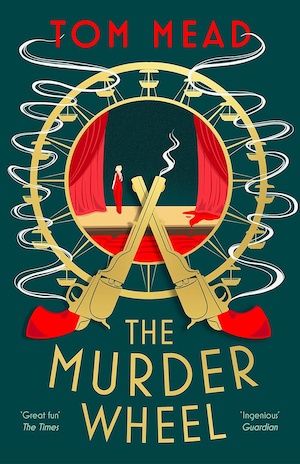
Tom Mead’s debut, Death and the Conjuror, introduced us to amateur sleuth Joseph Spector. It landed with a splash, readers taken with the author’s ingenious double locked-room murder mystery, which played well on one of the oldest formats in the genre. The Murder Wheel is a new adventure for illusionist Spector and a deeper dive into the puzzles and archetypes that still fascinate fans of Agatha Christie, John Dickson Carr and others of that ilk.
London, 1938. While Prime Minister Neville Chamberlain is off to Munich to negotiate with Hitler, life goes on in the metropolis. The Ferris Wheel Murder case seems to be an impossible crime and it has the press and public gripped. The Chronicle has even offered £2,000 for a solution to the mystery. That’s assuming the mild, pious widow Carla Dean didn’t do her husband in.
Carla is represented by young lawyer Edmund Ibbs, who is fascinated by illusion and the art of magic. The morning of his visit to the women’s prison Holloway to see his client, he receives a rare book entitled The Master of Manipulation. Perhaps his interest in magic can help him fathom the mystery?
Carla is charged with killing her husband Dominic while the two were alone in a carriage on the Ferris wheel at a fair. Dominic was shot in the stomach while the wheel was rotating. Carla can offer no explanation except that she didn’t do it. She gives Ibbs one clue. A man with a limp appeared to be following them. Proving Carla’s innocence will not be easy as the evidence is damning. Uncertain how to proceed Ibbs, makes a nuisance of himself interviewing the witnesses. Then he stumbles upon something surely connected.
Dominic Dean was a bank manager. His mood had changed following a recent robbery in which the nightwatchman was beaten to death. Inspector Flint of Scotland Yard is certain master criminal Titus Pilgrim was behind the heist, but he can’t prove it and his colleagues think he has a vendetta against Pilgrim. Flint also thinks Carla is probably guilty but offers advice to Ibbs. If anyone can disprove this and uncover the plot, if one exists, then it is Joseph Spector the illusionist and amateur detective.
Matters become complicated when, at the Pomegranate theatre, Ibbs becomes the prime suspect in the murder of illusionist and escapologist Paolini and the Ferris wheel operator, whose body mysteriously turns up there too. The fact that Ibbs was alone in a locked room with the body of Paolini seals Ibbs guilt as far as Flint is concerned.
Fortunately for Ibbs, Spector smells a rat, but proving he’s innocent and uncovering what happened at the Ferris wheel and during the bank robbery will be a test for even the sharpest mind and time is running out.
The Murder Wheel is an exemplar of the murder mystery as a puzzle within a puzzle, designed to engage the reader in the game of solving the crime. Good luck, too. The book has a nutty and complex set-up, but then that’s the fun for readers of this kind of novel. Homage is one thing but actually taking the Golden Age formula and adding something new to the work of past greats is rare, yet Mead does it.
He draws inspiration from the notorious cases of the day, for example the Edith Thompson affair and other miscarriages of justice. Mead has a taste for the strange and apparently insoluble mysteries of the 1930s and that feeds into the plot. His love of Spector’s world of magic and illusion shines out. Clearly another area well researched. There’s more than one puzzling murder here and the locked room is revisited. It’s all very clever, however, those who aren’t devotees of the Golden Age and puzzle mysteries may find the novel less intriguing. The author provides footnotes, as he did with the first novel. These point to clues earlier in the book during the reveal, perhaps signposting the complexity of the game afoot.
Death and the Conjuror gave us a feel for a bygone age with a fuller back story. The Murder Wheel has a more claustrophobic feel as the action is confined to the murder mysteries and their resolution. It’s easy to see why Golden Age readers in Britain and America have taken to Spector. This novel improves upon the first and now leaves us wondering how Mead will be able to up his game for Spector’s next outing.
Where Flint sees what’s in front of him – what the murderer or murderers intended everyone to see – Spector sees the subterfuge. All the devious machinations become clear only with the final reveal, then everything makes sense. And there’s a surprise or two in store.
Young Ibbs the lawyer is a well drawn character, he carries a lot of the plot but Spector is the truly fascinating invention. He has a unique skillset and a Sherlockian perspicacity. Those who love playing ‘the game’, will be enthralled. It is well trodden territory but Mead has a rare talent for refreshing and energising the classic form.
See our 10 of the best Golden Age crime novels from 2014.
Head of Zeus
Print/Kindle
£5.99
CFL Rating: 4 Stars
Using these associate/affiliate links helps support our site.